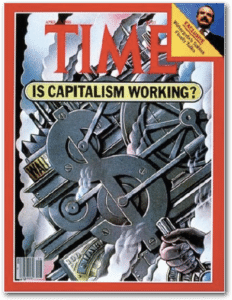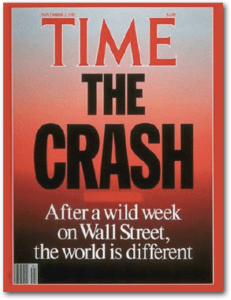Executive Summary: People tend to be drawn to “bad” more than “good”. Social scientists believe that our self-preservation instincts cause us to focus on bad stuff to protect ourselves from harm. Research shows that in America, news relating to terrorism, murders, and natural disasters, have consistently been the most compelling for decades. And because people pay attention to bad news, media outlets tend to focus on it.
Unfortunately—too often when it comes to investing—people actually act on bad news. We’ve passed through decade after a decade where similar themes get recycled: trade deficits, budget overruns, financial crisis, looming recession. In the meantime, innovation continually brings humanity wonderful new technologies. People figure out how to find more, create more, and use less as we steadily come up with life-improving innovations.
There’s good news out there, and even though you have to dig to find it, as humans we continue to climb to new heights. And this progress is reflected by global stock markets, which despite occasional adjustments, continue to push ever upward.
And the Winner Is …
I love film. As a musician, this year’s Oscar nominees were a real treat for me. Green Book, A Star is Born, Bohemian Rhapsody and even the new Spiderman animated film all had amazing soundtracks. It was a diverse group of nominees, with surprisingly great storytelling.
LA has been the destination city of the awards since 1929, and the setting for some of my favorite movies. Let’s see if you can guess this Oscar-winning film:
This movie came out in 1982. Imagine that we’re looking into the future—all the way to the year 2019. It’s a bleak perspective. Through the dust and pollution, you can see overcrowded LA streets bustling with multi-ethnic poor selling scraps and food to passersby in a citywide marketplace.
Beaming through the contaminated air are 20-story flashing electronic billboards on the sides of gigantic skyscrapers advertising the Offworld Colonies—the place where the rich are going to get away from Planet Earth’s sprawling cesspool. Can you guess?
The movie is the cult-classic Blade Runner, which got an update in 2018 that wasn’t quite as desperate or dreary as the original (and also had a solid soundtrack that won an Oscar for sound editing—well-done sound crew).
Well, here we are in 2019. We are in the future. As you look around, there are a few things you don’t see: those impressive superstructures in LA (have you seen Hong Kong lately?); flying cars; a collective cultural desire to escape from Earth to space colonies (we do have cell phones though, which are strangely missing from director Ridley Scott’s futuristic film).
What you actually see today is far better than Scott’s grim future. Our global prospects are actually as good as they’ve ever been in many ways. Don’t believe me? Take a closer look.
Some Surprising Good News
Recently, the New York Times ran a story called Why 2018 Is the Best Year in Human History!,1 which reports that 300,000 people around the world gained access to electricity for the first time. Even more impressive is every day another 305,000 people got access to clean drinking water. Plus, an additional 620,000 people got online for the first time—each day in 2018.
And the good news doesn’t stop there as the Times reports the worldwide child death rate is falling. It was 4% last year, 7% in 2003, and a shocking 19% a little over 50 years ago (in 1960 global life expectancy was 52 years, it’s now 72 years).
Aha, you say. Greater life expectancy means more people with fewer resources available on our increasingly crowded planet. You’d be wrong too—and you can be forgiven as looking for the bad is what we do since we’re constantly bombarded with it in news cycles where pushing fear leads to greater viewership or more clicks.
In fact, resources have become increasingly cheap and more abundant. The Simon Abundance Index (developed using data on 50 different commodities and their price trajectories over the past 37 years) indicates that the price of agricultural, forestry and energy resources decreased by an average of 36.3 percent between 1980 and 2017.2
The Future is Even Brighter
The Wall Street Journal began its recent article, The World is Getting Quietly, Relentlessly Better with this, “If you spent 2018 mainlining misery about global warming, inequality, toxic politics or other anxieties, I’m here to break your addiction with some good news: The world got better last year, and it is going to get even better this year.”3
The Journal then goes on to report that global poverty is dropping and half the world can now be considered middle class. And World Bank statistics support their claims with studies that show people living in extreme poverty has fallen from 36 percent of the world’s population in 1990 to 8.6 percent last year.4
The Collective Power of Our Brains
Global advances happen as people figure out how to find more, or create more, or use less. Scarcity is scary, so the news media loves doomsday forecasting. But take a look around and what you’ll see is abundance.
“Earth’s greatest natural resource is the human brain. And it may also be among the least appreciated, judging from the persistent doom and gloom, going back centuries, over the supposed menace of overpopulation. Wishing for fewer human brains on Earth is like wishing for fewer diamonds or rubies.” That’s from a Washington Post article titled, Don’t fall for the doomsday predictions.5 I love that. I believe it too.
Just for kicks, check out this link to a Smithsonian article on how floating farms in the future can help us stay ahead of the food demands of our increasing population.6 For the Cliff Notes version, imagine huge triple-decker, barge-like farms floating on the open sea in the harbors of large port cities and producing tons of food annually—fisheries on the bottom, hydroponic gardens next, and solar panel roofs running everything. It’s an idea that checks a lot of boxes on today’s “green” list: preservation of arable land; local organic food sourcing; self-sustaining; environmentally sound. It’s wildly beyond what my grandpa could have imagined, but I’m sure I’ll see something like this in my lifetime.
Unfortunately, Bad is More Compelling Than Good
All this positive news may come as a bit of a shock. That’s because “bad” takes precedence over “good,” and the reasons why have been studied for decades. I’ll save you the scholarly research and just summarize: people respond to bad much more strongly and more consistently than they respond to good. Most psychologists believe this happens because of our normal human tendency to lean towards self-preservation or survival. Bad things can kill, hurt, or harm us.
If you’re like me, and you want the meat and potatoes—I’d recommend checking out this paper entitled “Bad is Better Than Good” in the Review of General Psychology.7 The conclusion states:
“In our review, we have found bad to be stronger than good in a disappointingly relentless pattern … In our view, this difference may be one of the most basic and far-reaching psychological principles.”
Pew Research shows that the type of news most popular with Americans hasn’t really changed for decades.8 War and terrorism consistently remain the most audience-generating type of news story, followed by bad weather (natural disasters get big viewership), and then money. Yep, money is at #3. And, as you might expect, the financial news follows the same trend where the negative gets watched more than the positive. And why not? News is a business, and bad is what people most often respond to.
Keep in mind when you read, hear, or see something that feels hyper-negative, that it’s not necessarily objective “advice.” In fact, Steve Forbes, of Forbes Magazine pragmatically shared this truth: “You make more money selling advice than following it. It’s one of the things we count on in the magazine business—along with the short memory of our readers.”9
Publishers know that financial advice doesn’t necessarily have to be right, good, or time-tested to sell TV ads, magazine spots, books, or e-newsletters. Beware of people who fill a stadium, pack a venue, or sell a course by intentionally, overemphasizing the negative. Negative financial news just works, so people push it, a lot. Mark Twain said: “If you don’t read the newspaper you are uninformed if you do read the newspaper you are misinformed.” Mark

Twain, still so good 150 years later.
All negative news is not inherently bad news. Negative news is an important part of reporting. But too often, people act on bad news way more often than they act on the good news. And that’s particularly true when it comes to investing and money. Decade after decade there are some similar themes that continue to recycle, almost to the point where you can’t tell exactly what year the headlines are from. They all feel eerily similar. Here are a few examples
from Time Magazine:

“In an age of economic anxiety, there are real and rising concerns about whether a free enterprise can surmount the problems of inflation, energy, and productivity. The relentless daily pounding of dismal news drives deeper the public’s conviction that the economy is in a profound and morose crisis.” So, what year? Does it feel current? This was from April 21, 1980.
Here’s another one: “Bankers now face their most strenuous survival test since the Great Depression…. Because of poor management, overzealous lending, and some bad luck, commercial bank profits have been battered. The clearest example of the industry’s chaos is the growing string of financial failures…” That’s 2009 financial crisis, for sure—the Great Recession, banks, and Wall Street were falling apart. How about Dec. 3, 1984.

“The U.S … could not go on forever spending more than it would tax itself to pay for, buying more overseas than it could earn from foreign sales, and borrowing more abroad than it could easily repay. There had to be a day of reckoning, and it could unhinge the whole world economy. On all the world’s stock exchanges, prices had leaped up too far, too fast, to be sustained.” Deficit spending and trade wars are still a concern, but this was a front cover for Nov 2. 1987, what was known as Black Friday.
Summary
Be careful when taking in your news and information. Don’t act on bad news, at least not without some cautious thought and contemplation. More often than not, the future is not as bleak as portrayed. And keep in mind, that your self-preservation instincts are often on high alert as you consume the news.
We should seek to continue to correct trade deficits, budget overruns, financial crisis, and looming recessions. But the good news is that innovation continually brings humanity wonderful new technologies. Innovators figure out how to find more, create more, and use less as we steadily come up with life-improving advancements.
You may not read it daily, or see it nightly, but our collective brain power is the primary reason a global stock market works. And the collective value of everything we’re doing is represented by global markets that will continue to reflect our innovations as we climb to new heights, occasionally stumble, and then keep climbing up again.
If a large part of everyone’s collective brain, hard-work, and innovation is reflected in my investment portfolio, I for one, feel like we’re in good hands.




